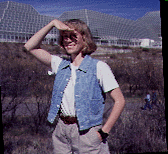|
Other articles:
Maestro

Earth 2
With Biosphere 2 as their personal lab,
Kristi Argenbright and two other TCU students spent a semester in the
Arizona desert trying to understand Mother Earth and learning how to conserve
her.
By David Van Meter

 ALL LIFE ON EARTH exists in a thin layer of air, water and soil that blankets our planet. This is the first biosphere.
ALL LIFE ON EARTH exists in a thin layer of air, water and soil that blankets our planet. This is the first biosphere.
The second one, Biosphere 2, sits high in the Sonoran desert, nestled in the Santa Catalina Mountains overlooking Tucson. And what a setting it is. Herds of javelinas run wild out here. Howls of coyotes and hoots of owls rule the night. Bighorn sheep can be seen at dawn, as can the footprints of mountain lions. Saguaro cacti, silent, stable, seem to be the soul of the place.
And then, as the sun peeks over Mt. Lemmon on this spring day, the light hits what just doesn't seem right, not out here anyway -- a brownish-yellow blanket of pollution smothering the view below and smacking the conscience of those who have contributed to that line of sight.
TCU junior Kristi Argenbright has seen it. It's the same color as the cloud that sometimes hangs over her home in Grapevine, a Dallas suburb. Or the haze that can be seen even from TCU on a still day. But Argenbright is optimistic, and for good reason. She is one of three TCU students who participated in an "Earth Semester" this past spring, among 49 handpicked from schools that include Columbia, Yale, Brown,
UC-Berkeley and Notre Dame. Columbia University leased Biosphere 2 last year, and TCU signed on as its first partner in changing the desert lab into an ecological campus.
As of March, seven schools were partners and at least 20 others had sent one student or more to participate in Earth Semester. In answering the age-old academic question, Why do I need to learn this?, the reply from these students is almost a given. To ensure a sustainable future for the inhabitants of Earth.
"I always thought that there was just something too different about nature and humans," Argenbright said. "But one of the main themes we've learned is that someday maybe we can develop a system where the two can coexist."
A ragtag bunch, these undergraduates are. Holes in jeans are matched by a lack of pretenses and a multitude of majors. A commune-like existence pervades, but instead of passing illicit substances, these students rally around ideas, that if they can learn how the Earth works, they are better equipped to change its current downhill course.
And why shouldn't they feel that way; they conduct studies of animal life in the surf of the Sea of Cortez to see if and how El Niņo and resort development are affecting it; they examine the geological structure of the Guadalupe Mountains in Texas to understand that the Earth is not static; and they study inside the biosphere itself -- a tropical rainforest, savanna, ocean, desert, marsh and an agricultural area, quarantined by glass above and steel below.
"These are the brightest students from all over, full of curiosity, helping us to understand the Earth's five environmental types in the biosphere," said biome manager Adrian Southern. "The students are collecting data at a rate that we could never achieve without them. Hopefully, once we know exactly what we have in the biosphere, we can change the conditions and identify problems over time. In a sense, you could say the students are the biosphere's immune system."
Remember that smog in Tucson and probably where you live, too? One of the problems it brings is carbon dioxide in the Earth's atmosphere, which at high levels causes the Earth's atmospheric temperature to rise because heat cannot escape at the usual rate.
The biosphere, as it turns out, is an ideal setting to study this dangerous phenomena. Its greenhouse-type structure causes it to also produce high levels of carbon dioxide, and thus the 3.15-acre steel-and-glass structure can measure, and even speed up, the effects of the gas build-up.
How will plants adapt to such a greenhouse world? Will they need more or less water? More or less fertilizer? The answers to these questions belong to some other semester's students; ultimately, they will model the rainforest on computer and virtually accelerate the global warming process to see what's in store for us in the years to come.
But Argenbright pioneered the effort, hanging in a harness for hours at various altitudes, recording the rainforest's plant volume and carbon dioxide levels.
And she still left with a lesson that seemed to be part of every assignment:
"Out here, you're not distracted by the technology stuff, and I've found that I really enjoy the way of nature," said
Argenbright, still a sucker for a good cappucino but no longer the city girl she once was. "I used to think preservation was the way to go -- set off pristine environments and don't allow any human intervention. Now I see that we must take more of a conservation issue, a marriage of the humans and the environment.
"Whether we like it or not, everything
on this earth is connected together."

top
|



